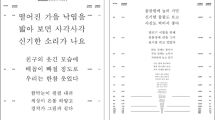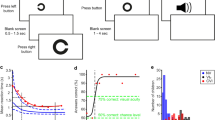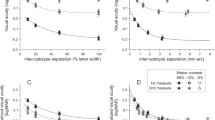Abstract
The spatial resolving capacity of the visual system is usually measured with charts containing letters of different sizes displayed in horizontal rows or, less often, in vertical columns. Although previous studies suggest that acuity may not be equal for these two arrangements1–7 it is implicitly assumed in clinical tests that orientation of an array of letters is of no consequence to the measurement. The work reported here shows that this assumption is incorrect. While undergoing an examination in an eye clinic, I noticed that letters of a given size seemed more difficult to identify when they were arranged in vertical compared with horizontal arrays. Subsequently, I tested a group of subjects using letters presented pseudo-randomly with different inter-letter spacings, in rows or columns. Subjects were required to identify letters from left to right or from top to bottom in each isolated row or column. A significantly higher number of errors was made for letters in columns than for those in rows. The effect does not depend on order or direction of letter presentation, and it is not found when acuity determinations are made using a non-letter test symbol. To explore the conjecture that the effect could be associated with previous experience, two additional groups of subjects were tested. First, bilingual Chinese, whose first language is read in both horizontal and vertical arrays, were tested using Chinese characters and English letters. Second, acuity determinations were made with young children who could identify letters but did not read. In each case, acuity was not significantly different for horizontal or vertical presentations, a finding consistent with the notion that learning may influence the development of visual resolution.
This is a preview of subscription content, access via your institution
Access options
Subscribe to this journal
Receive 51 print issues and online access
$199.00 per year
only $3.90 per issue
Buy this article
- Purchase on Springer Link
- Instant access to full article PDF
Prices may be subject to local taxes which are calculated during checkout
Similar content being viewed by others
References
Mishkin, M. & Forgays, D. G. J. exp. Psychol. 43, 43–48 (1952).
Orbach, J. Am. J. Psychol. 65, 555–562 (1952).
Aulhorn, O. Pflügers Arch. ges. Physiol. 250, 12–18 (1948).
Tinker, M. A. J. exp. Psychol. 68, 444–449 (1955).
Bryden, M. P. J. exp. Psychol. 84, 120–122 (1970).
Mewhort, D. J. & Beal, A. L. J. exp. Psychol.: Hum. Perception Performance 3, 629–640 (1977).
Krueger, L. E. Cognitive Psychol. 1, 341–357 (1970).
Duke-Elder, S. & Abrams, D. System of Ophthalmology Vol. 5 (Klimpton, London, 1970).
Appelle, S. Psychol. Bull. 78, 266–278 (1972).
Freeman, R. D. & Thibos, L. N. J. Physiol., Lond. 247, 687–710 (1975).
Flom, M., Weymouth, F. & Kahneman, K. J. opt. Soc. Am. 53, 1026–1032 (1963).
Loomis, J. M. Vision Res. 18, 335–339 (1978).
Author information
Authors and Affiliations
Rights and permissions
About this article
Cite this article
Freeman, R. Visual acuity is better for letters in rows than in columns. Nature 286, 62–64 (1980). https://doi.org/10.1038/286062a0
Received:
Accepted:
Issue Date:
DOI: https://doi.org/10.1038/286062a0
This article is cited by
-
Age-related course of visual acuity obtained with ETDRS 2000 charts in persons with healthy eyes
Graefe's Archive for Clinical and Experimental Ophthalmology (2019)
Comments
By submitting a comment you agree to abide by our Terms and Community Guidelines. If you find something abusive or that does not comply with our terms or guidelines please flag it as inappropriate.



